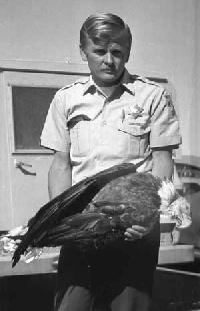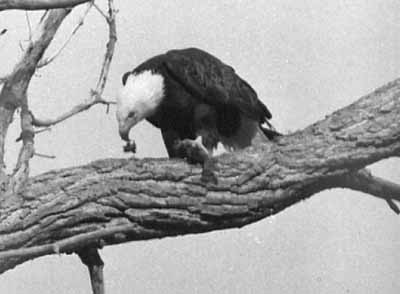|
He was born in the mid-1960's in high mountains near Juneau, Alaska. In 1970 a hunter spotted him flying low over a forest, took aim, and fired. Silver, shot in the wing, crashed through the trees to the ground. Bleeding and starving, he lay on the ground for days before another hunter found him. He tried to nurse Silver back to health but finally turned the bird over to federal officials who sent him to the San Francisco Zoo to recuperate. For the next few years the bird paced back and forth on a concrete floor in a small cage while thousands of people viewed the forlorn representative of the national symbol. When it was time for Silver's first flying lesson Caughlan tossed him into the air. With two great flaps of his wings he crashed to the ground. Over and over, for weeks, the man and bird worked together. By the end of the fourth months Silver was flying, dragging a 200-foot rope attached to his leg. In the summer of 1974 Silver and a young female, Jane, were crated and transported to Ruby Lake National Wildlife Refuge, 60 miles southeast of Elko, Nevada for release. They were put in a wire shelter for two weeks and did their fishing from a large trough while becoming familiar with the place while waiting for their freedom. Finally, on August 3rd, refuge rangers and press representatives gathered on a hillside near the marshes. Jane was released first. Caughlan and refuge manager Ron Papike cut the tether bracelets and Jane flapped into the air and flew out of sight. Now it was Siver's turn. Papike cut the jesses and Caughlan thrust Silver
in the air saying, "Silver, fly free!" The huge bird took off, glided down
the hillside and just about the distance at which the 200-foot tether normally
stopped him he landed.
 Again and again, Caughlan launched the bird and he would fly a short distance and land. On the seventh release Silver finally realized there was no rope hindering his flight and he flew free. Caughlan bid his old friend a reluctant goodbye and returned to San Francisco. A new chapter began in Silver's life. At first he often returned to his first home, the wire cage, at the refuge headquarters. As he became used to freedom he began exploring more of the marsh area. During the next few months he perched on fenceposts, signs, or high
in a tall tree while surveying the scene. He was keeping an eye on fishermen.
His greatest delight was badgering, threatening, or begging from an angler
until he as given a fish for lunch. Several people reported that when they
returned to their fish strings Silver had appropriated all their fish.
 Once in a while he caught coots and, like all good bald eagles, learned to snatch food from local prairie falcons. A car killed rabbit provided an occasional dinner. Residents of northeastern Nevada heard stories of the semi-tame bird and drove out to the marshes to see him. Hundreds of people saw Silver and many considered him a friend. Seeing a bald eagle up close is a rare experience and he became a celebrity. Caughlan visited Silver a few months after his release and the eagle recognized him. Silver seemed to have a happy, free life. Then, on June 25, 1975 a retired California policeman explained to law enforcement officials, "I saw something white in the sagebrush and shot it." Silver was dead. He was ten-years-old. Fined $550, the killer had his rifle confiscated and was sentenced to
six months in jail. Because of ill health, the jail term was suspended.
Ironically, he paid his fine with a check embossed with a picture of a
bald eagle.
 Knowing nothing would bring Silver back to life but realizing he could be a lesson on display Northeastern Nevada Museum staff applied for a federal permit to exhibit the bird. Local, state, national, and Indian officials along with many area residents, wrote letters and made phone calls to federal offices to help get the permit. Silver's body, kept frozen for months, was sent away for freeze dry taxidermy. A year after his death, Elkoans Ben and Connie Lesbo flew Silver back to Elko in their private plane. Silver had made his last flight. Elko's Nevada Civic Club collected and sold 77,000 aluminum cans to help build a special exhibit case. Silver's taxidermy bill was paid by the Ruby Lake National Wildlife Refuge office. A month later the museum opened Silver's display and honored him as a representative of our national symbol - a fitting tribute during the Bicentennial Year. At the opening Caughlan said to the crowd, "Better ten months of freedom than ten years behind bars." More than a million people have visited Silver at the museum, other millions watched him on public television in a documentary film, and untold numbers of students have seen Silver's filmstrip in their classrooms. He is probably the most publicized bird in the nation. Although his exhibit is a tremendous attraction for the museum everyone
wishes he was back at the marshes holding forth as the celebrity he was,
savoring cherished freedom in the sky and hobnobbing with his many people
friends.
 Thanks to Larry Caughlan for helping write the original manuscript about
Silver in 1976. A recent Christmas card from Lar reminded me that Silver's
story needed to be told again. Whenever I visit the museum and see Silver
on display I am still troubled about his needless death. If you have not
visited Silver at the museum take a few moments to see this magnificent
bird up close
26 December 1998
©1999 by Howard Hickson and Larry Caughlan. If any portion or all of this article is used or quoted proper credit must be given to the authors. |